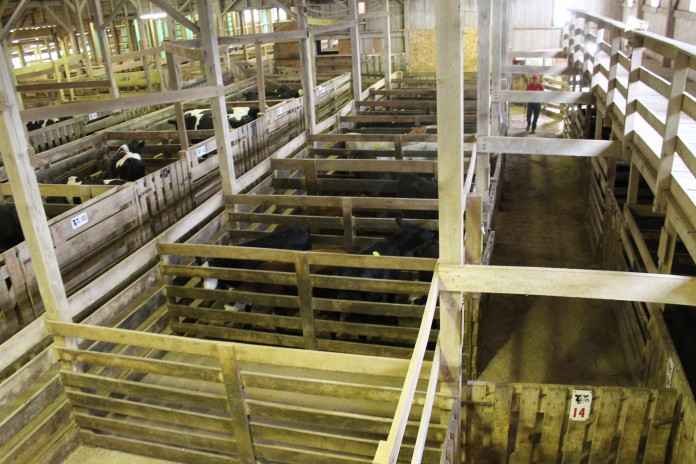(Editor’s note: This story is one of a two-part series on the livestock and hay markets. Check back next week for a second story on understanding the hay markets.)
SALEM, Ohio — Sometimes, purchasing or selling livestock at the auction barn is a roll of the dice. Let’s face it: The livestock markets are a bit more complicated than the hay market reports.
There are a number of classes in each type of livestock and each class has a great number of variations.
It’s important to note that the USDA reports are collected out of the auction barns themselves voluntarily. The mandatory price is collected out of packing houses. The packing houses that report the prices are those that kill more than 125,000 cows a year, 100,000 hogs and 75,000 sheep.
The New Holland, Pennsylvania, market is typically one that is highlighted because it is often the middle market to the feedlots. Levi Geyer, officer in charge, Livestock, Poultry and Grain Market News Division, USDA Agricultural Marketing Service, said it is a good market for the USDA to capture all levels of animal production.
Beef markets
For cattle, the markets start by classifying them as cattle, then sex, then their body condition is evaluated.
Slaughter steer: The USDA classifies it as a steer younger than 30 months of age. Other classification include slaughter heifers, then slaughter Holsteins, then the grocery store and retail side. Below that is slaughter cows and slaughter bulls.
The person selling the beef looks at the outside of the cow and makes assumptions based on the quality and sex of the animal. The choices can be: select, prime, premium and choice.
Then the auction barn also determines different groups within the class, which is how the price per hundredweight is decided.
Geyer explains a steer weighing 100 pounds that sells for $1.25 a pound would then cost $125.
Problems
Geyer said it’s a problem when cattle markets have a beef cow that is too heavy, which is often above the 1,600-pound market. The beef would be sold for wholesale beef cuts and is hard to manipulate.
Think of it as a 24-ounce steak, Geyer said. The market for a steak that size is small.
Another problem with cattle that aren’t considered average size is that the beef itself doesn’t fit in the boxes the industry uses to get the meat to grocery stores.
Feeder cattle
The feeder cattle market is like any other, with a number of factors that influence it. Typical classes are feeder steers, bulls, Holsteins and heifers. Animals are then classified by their frame size and muscling.
Steers ranging from 1,100 pounds to 1,250 pounds are expected to grade U.S. Choice. Heifers from 1,000 pounds to 1,150 pounds are expected to grade U.S. Choice.
Steers that have large frames above 1,250 pounds are expected to grade U.S. Choice. Heifers with large frames above 1,150 pounds are expected to grade U.S. Choice.
Steers with a small frame less than 1,100 pounds are expected to grade U.S. Choice, and heifers less than 1,000 pounds are expected to grade U.S. Choice.
One thing to note that buyers don’t take into consideration is that thin-fleshed or cattle that haven’t had enough “groceries” will bring higher prices in the feeder cattle market. The reason is simple, Geyer said. The thin cattle will gain faster and that’s often what feeder cattle buyers are looking for in the market.
Geyer said another consideration in the feeder cattle market is spoiled cows, meaning cows that have been suckling on the mother and creep fed. The cattle will lose baby fat when they enter a new environment and will be discounted, which is why they don’t do well in the feeder cattle market.
Another price consideration is how big of a frame and how much muscling the cow has when it enters the sale ring, which can help predict the quality and yield grade. There is often a price premium for heavily muscled cattle. These cattle include the Continental breeds, such as Limousin and Charolais. The thinner-muscled cattle breeds are the English breeds, such as a Herefords, as well as the dairy breeds. Geyer said the corn price also impacts the livestock markets. “It costs money to feed the cows,” he said.
Yearling cattle
Geyer said the market history shows that yearling cattle sell better than calves.
However, if calves are already weaned, then a producer can sometimes get a good price depending on the time of the year. He said some producers in the Midwest like to run calves on wheat pastures and that impacts the markets.
Sheep and goat markets
Geyer said the sheep and goat markets are ethnically based and most often sold for slaughter.
Typically, he added,the market is not focused on quality, so the terms, prime, choice and good are often not used. Instead the buyer is focused on its confirmation, or how the animal looks alive. Geyer said between 97 and 98 percent of lambs are sold grade choice. The remaining percentage is sold prime choice.
There is no grading for bucks sold. However, ewes are graded as good, utility or cull.
Goats are sold by thick muscling, average or thin muscling, and then the grades are broke into buck, billy, kid or a female goat.
Hog markets
Hogs are sold per hundredweight when they are auctioned and average between 220 and 320 pounds.
Geyer said there is not a lot of variation in them at the auction houses. However, hog weights have gotten heavier over the years.












I think this is a great article and should prove to enhance the public understanding of the operation of livestock sales to the average citizen. hopefully it will encourage more citizens to participate in the livestock sale barn auctions.
I saw a auction market which listed some of the kid goats as “fancy” and they got a great price. What does the term fancy mean? Is this some sort of specifi breed?